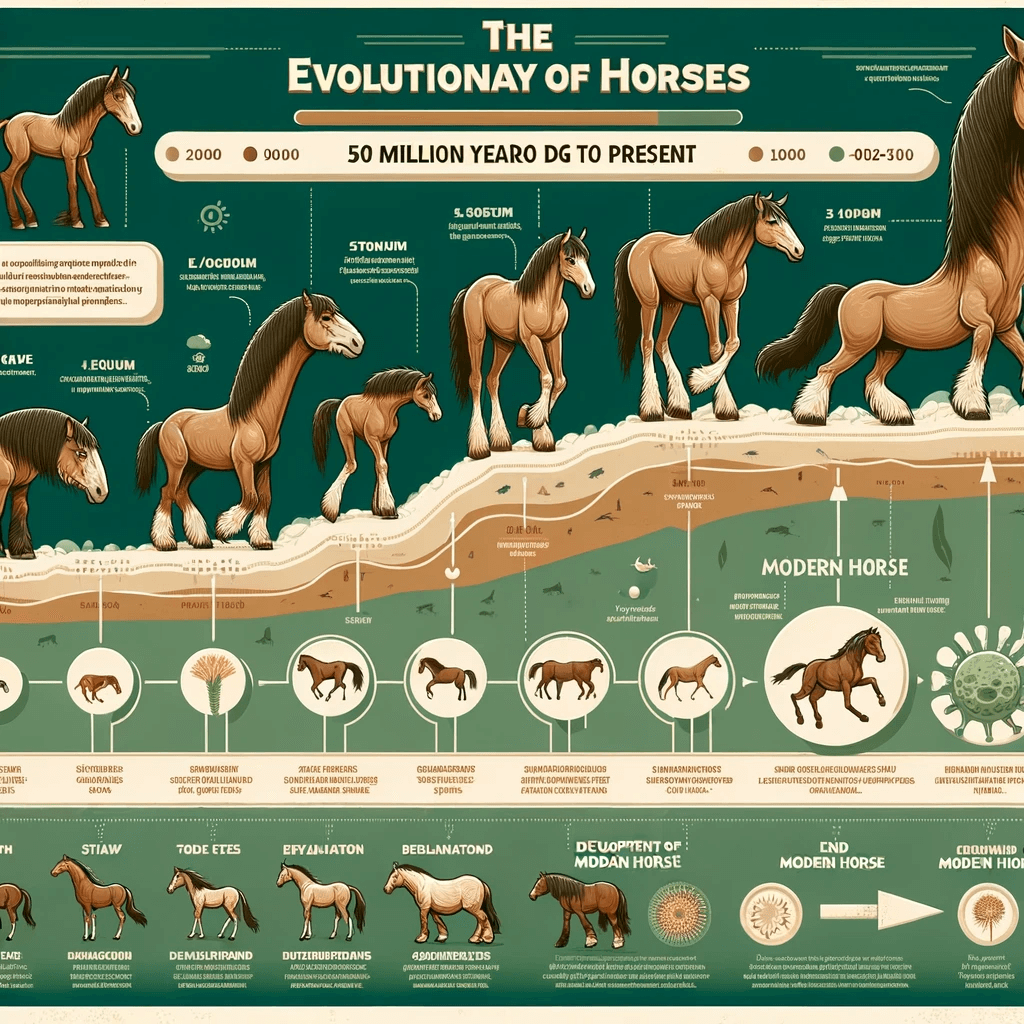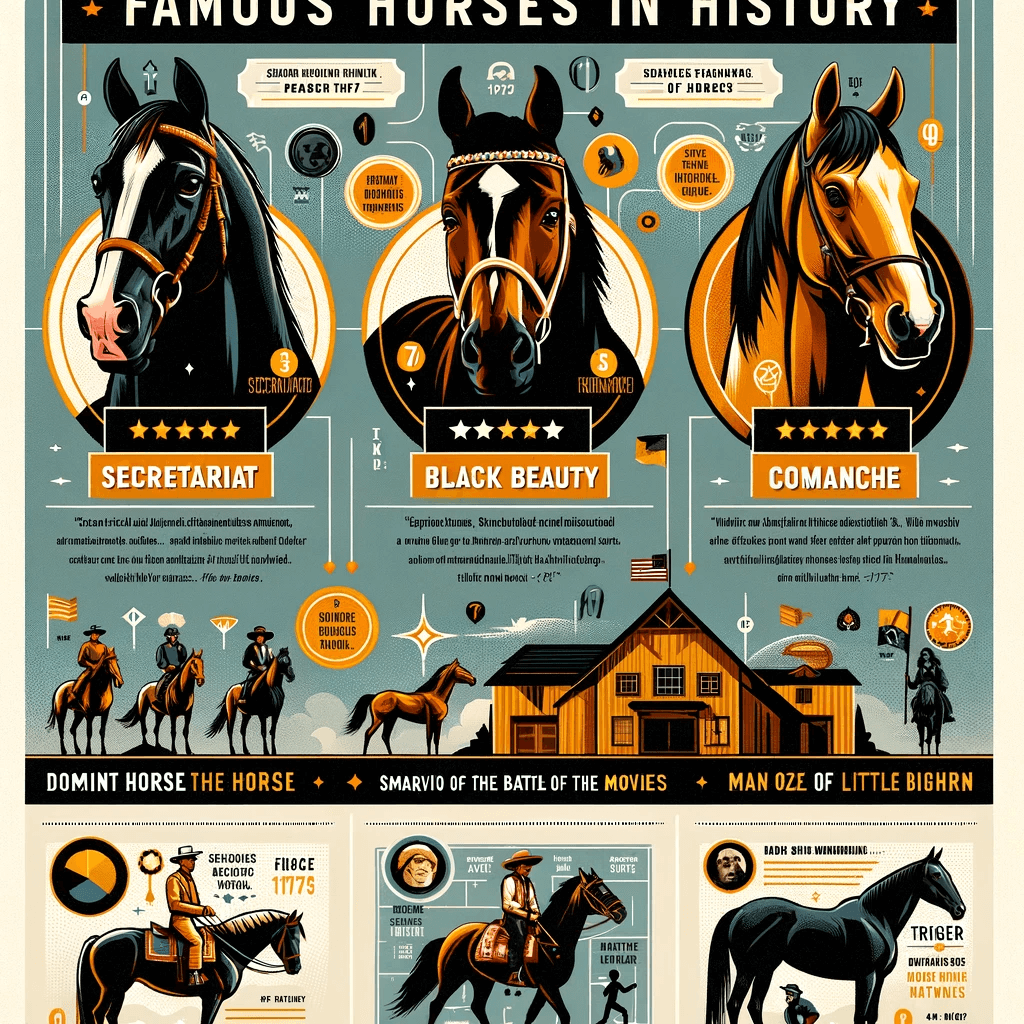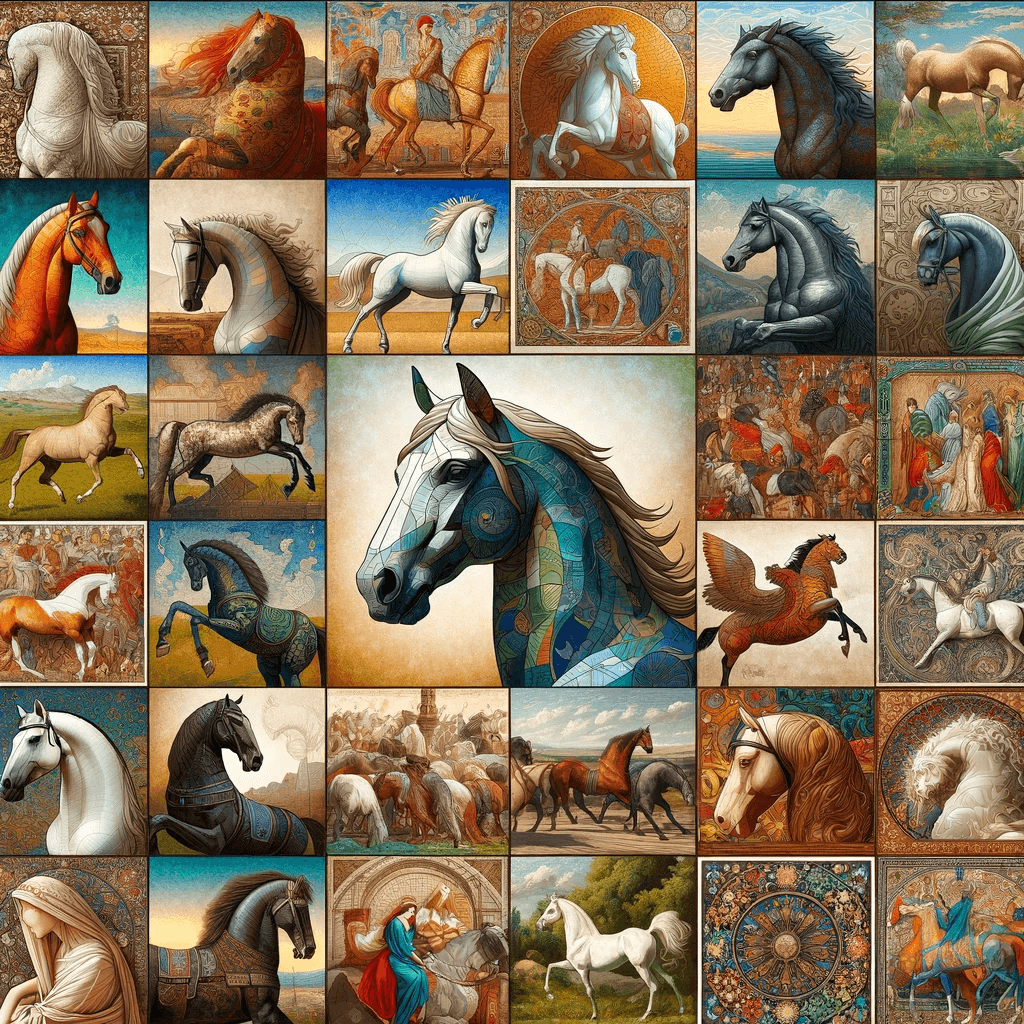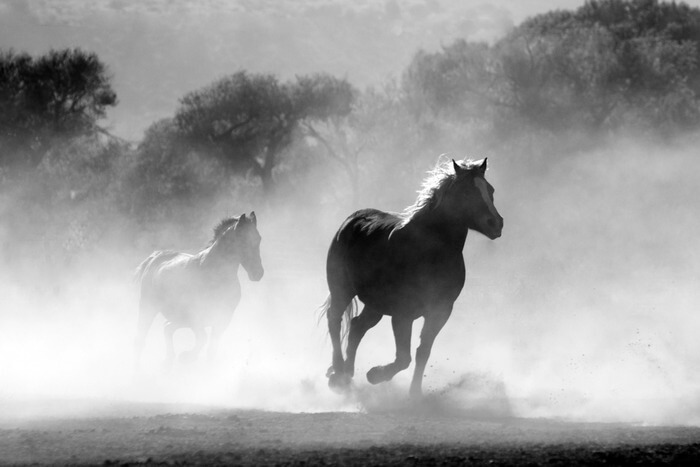Introduction:
Horses are among the most majestic and iconic animals on Earth. Their grace, power, and beauty have captured the hearts of humans for centuries. But have you ever wondered where these magnificent creatures come from?
In this article, we embark on a journey through time and delve into the origins of horses. From their ancient ancestors to their domestication and global spread, we’ll uncover the fascinating history of these incredible animals.
Read More: What Jobs Involve Horses
The Ancient Ancestors of Horses

Horses have a long and fascinating evolutionary history, dating back millions of years. Their journey from small, multi-toed creatures to the magnificent single-toed animals we know today is a testament to the power of adaptation and natural selection.
The Eohippus: A Tiny Ancestor
The story of horse evolution begins with the Eohippus, a tiny creature that lived about 50 million years ago during the Eocene epoch. This early ancestor was about the size of a small dog and had multiple toes on each foot. Its lifestyle was quite different from modern horses, as it was adapted to forested environments and had a browsing diet.
The Evolutionary Journey
Over millions of years, these ancient ancestors underwent significant changes. They gradually adapted to changing environments and evolved into larger, more specialized creatures. One of the key developments was the transformation from multiple toes to a single toe on each foot, which greatly enhanced their ability to run.
The Dawn of the Equine Evolution
The evolution of horses is a captivating story of adaptation to changing environments and natural selection. It highlights the gradual development of key anatomical features that allowed horses to thrive and become the magnificent animals we recognize today.
Geological Time and Horse Evolution
Horse evolution spans millions of years, with various species appearing in different geological epochs. Understanding the geological context is essential to tracing the steps of this evolutionary journey and appreciating the changes that occurred.
Anatomical Transformations
During their evolution, horses developed a series of adaptations that significantly influenced their survival and success. These adaptations include elongated limbs, a single toe with a hard hoof, specialized teeth for grazing, and an enlarged nasal passage that facilitates breathing during high-speed running. Each of these developments played a crucial role in their ability to thrive in various environments.
Read More: Are Horses Ruminants
Horses in the Wild: The Przewalski’s Horse
While horses are now primarily domesticated, one surviving wild horse species serves as a link to their ancient heritage: the Przewalski’s horse. This remarkable creature offers a glimpse into the past, providing valuable insights into the original characteristics of wild horses.
Last Wild Horse on Earth
The Przewalski’s horse, also known as the Mongolian wild horse or takhi, is the only remaining truly wild horse species on the planet. It inhabits the remote and rugged regions of Mongolia and China. Its unique status as a wild horse makes it a subject of considerable scientific interest and conservation efforts.
Genetic Link to Ancient Horses
Genetic studies have revealed that the Przewalski’s horse shares a common ancestry with the ancient wild horses that once roamed the grasslands of Eurasia. This genetic connection underscores its importance as a living relic of horse evolution and a critical component of conservation efforts aimed at preserving the genetic diversity of the equine species.
Read More: Strangles In Horses
Which Horse Breeds are the Fastest?
The speed of a horse depends on various factors, including genetics, training, and individual capabilities. While there are many horse breeds known for their speed, a few stand out as some of the fastest:
Thoroughbred:
Thoroughbreds are renowned for their speed and are the stars of horse racing. They can reach speeds of up to 40-45 miles per hour in short sprints.
Arabian:
Arabians are known for their endurance and speed, often excelling in long-distance races. They can sustain speeds of 30-35 miles per hour.
Quarter Horse:
Quarter Horses are known for their explosive bursts of speed, especially in short-distance races. They can reach speeds of around 45 miles per hour.
Standardbred:
Standardbreds are famous for their speed in harness racing. They can maintain speeds of about 30-35 miles per hour.
American Paint Horse:
Paint Horses, known for their distinctive coat patterns, are also fast sprinters and can reach speeds comparable to Thoroughbreds and Quarter Horses.
It’s important to note that individual horses within a breed may vary in speed, and other factors like training, conditioning, and jockey/rider skill play a significant role in racing success.
Read More: When Do Horses Stop Growing
How do Genetics Influence the Color and Markings of Horses?
The color and markings of a horse are determined by its genetic makeup. The key genetic factors involved in horse color and markings include:
Coat Color Genes:
The most well-known genes related to coat color are the Extension gene (E), which controls the production of black or red pigment, and the Agouti gene (A), which determines whether the black pigment is distributed evenly or restricted to certain areas.
White Markings:
White markings on a horse’s face and legs are influenced by genes that control the extent and placement of white areas. Genes such as the White (W) gene and Overo (O) gene can produce various patterns of white markings.
Dilution Genes:
Genes like Cream (Cr) and Dun (D) can dilute the base coat color, resulting in variations like palomino, buckskin, and grullo.
Roan Gene:
The Roan gene (Rn) causes a horse to have a mixture of colored and white hairs throughout its body.
Grey Gene:
Grey (G) is a dominant gene that causes a horse’s coat to progressively lighten with age, eventually turning grey or white.
Spots and Patterns:
Coat patterns like leopard spots in Appaloosas or pinto markings in Paint Horses are influenced by specific genes that control the distribution of color.
It’s important to understand that the combination of these genes can lead to a wide variety of coat colors and patterns in horses, making them one of the most diverse species in terms of coat variation.
Read More: Why Do Horses Like Sugar Cubes
What are Some Famous Horses in History?

Throughout history, several horses have gained fame for their exceptional abilities, contributions, and remarkable stories. Here are a few notable examples:
Secretariat:
Often regarded as one of the greatest racehorses of all time, Secretariat won the Triple Crown in 1973 and set numerous records, including the fastest time in the Kentucky Derby.
Black Beauty:
Although a fictional character created by Anna Sewell in her novel “Black Beauty,” this horse became a symbol of animal welfare and inspired positive changes in the treatment of horses.
Trigger:
Known as the “Smartest Horse in the Movies,” Trigger was the beloved steed of Roy Rogers, a famous American cowboy and actor, and appeared in many films and television shows.
Comanche:
Comanche was a war horse known for his endurance and bravery during the Battle of Little Bighorn in 1876. He survived multiple gunshot wounds and became a symbol of resilience.
Man o’ War:
This Thoroughbred racehorse was dominant during the 1920s and is considered one of the greatest racehorses in history. He won 20 of 21 races and set several records.
These horses left a lasting legacy and continue to be celebrated for their remarkable achievements and impact on equine history.
Read More: What Temperature Is Too Hot For Horses To Be Outside
Can Horses Still Be Found in the Wild Today?
Yes, while domesticated horses are prevalent worldwide, there are still wild horse populations in various regions. One of the most well-known examples is the Przewalski’s horse (Equus ferus przewalskii), native to the steppes of Central Asia. It is the only surviving truly wild horse species on Earth. Efforts have been made to reintroduce Przewalski’s horses to their natural habitats, as they were once on the brink of extinction.
Additionally, there are feral horse populations, such as the Mustangs in North America. These are descendants of domesticated horses that escaped or were released into the wild. Mustangs can be found in areas of the United States, particularly in the western states.
How Do Horses Contribute to Therapy and Rehabilitation Programs?
Horses play a significant role in therapy and rehabilitation programs, a practice known as equine-assisted therapy (EAT) or hippotherapy. Here’s how they contribute:
Physical Therapy:
The rhythmic motion of a horse’s gait helps individuals with physical disabilities improve balance, muscle strength, and coordination. This is particularly beneficial for people with conditions like cerebral palsy.
Occupational Therapy:
Horses can help individuals with sensory processing disorders, autism, or developmental delays. Working with horses encourages sensory exploration and improved motor skills.
Emotional and Psychological Benefits:
Interacting with horses can be emotionally therapeutic. The bond between humans and horses can promote confidence, self-esteem, and trust. It’s especially effective for individuals with anxiety, depression, or trauma.
Rehabilitation from Injuries:
Horses are used in physical and emotional rehabilitation programs for veterans and individuals recovering from accidents or trauma. The partnership with a horse can aid in mental and physical healing.
Read More: Gastric Ulcers In Horses
What Are Some Common Health Issues That Affect Horses?
Horses, like any animals, can face a range of health issues. Common equine health concerns include:
Colic:
A broad term for abdominal pain, colic can be caused by various factors, including gastrointestinal issues and diet.
Lameness:
Horses can experience lameness due to injuries, arthritis, or issues with their hooves and limbs.
Respiratory Problems:
Conditions like heaves or recurrent airway obstruction can lead to breathing difficulties.
Dental Issues:
Dental problems can affect a horse’s ability to eat and may require regular dental care.
Parasitic Infections:
Internal and external parasites, such as worms and ticks, can affect a horse’s health.
Hoof Problems:
Conditions like laminitis or thrush can impact the health of a horse’s hooves.
Equine Infectious Diseases:
Diseases like equine influenza and strangles can affect horses and may require vaccination and quarantine measures.
Proper nutrition, regular veterinary care, and attention to stable conditions are crucial in maintaining a horse’s health and preventing these issues.
Read More: How Much Grain Does A Horse Eat Per Day
What Is the Future of Horses in a Modern World Dominated by Technology and Machinery?
In a world increasingly dominated by technology and machinery, horses still hold a valuable place. Here’s what the future may look like for horses:
Recreation and Sports:
Horses continue to be beloved companions for recreational riding, equestrian sports, and entertainment. Their role in these areas is likely to remain strong.
Therapy and Rehabilitation:
As our understanding of equine-assisted therapy grows, horses will continue to contribute to physical and emotional healing for people with various conditions.
Agriculture:
While machinery has replaced horses in many agricultural tasks, there is a resurgence of interest in sustainable and eco-friendly farming practices. Some farmers are reintroducing horses for plowing and other farm work.
Conservation:
Efforts to protect and conserve wild and feral horse populations, like the Przewalski’s horse and Mustangs, will likely continue to ensure their survival.
Cultural and Traditional Roles: In cultures and communities where horses hold historical and cultural significance, their roles will persist.
The Role of Horses in Art and Culture Throughout History

Symbolism and Representation in Ancient Art
Early Cave Paintings and Sculptures:
Horses have been depicted in art since prehistoric times, evident in cave paintings and small sculptures. These depictions often symbolized power, freedom, and the natural world.
Ancient Civilizations:
In ancient Egypt, Greece, and Rome, horses were represented in various forms of art, including frescoes, mosaics, and sculptures, often as symbols of status, power, and divine connection.
Horses in Medieval and Renaissance Art
Illuminated Manuscripts and Tapestries:
During the medieval period, horses were prominently featured in illuminated manuscripts and tapestries, symbolizing chivalry and nobility.
Renaissance Masterpieces:
Artists like Leonardo da Vinci and Raphael often included horses in their works, showcasing them as noble creatures, integral to the themes of heroism and beauty.
The Role of Horses in Folklore and Mythology
Mythological Creatures:
Horses have been central to many mythologies, such as Pegasus in Greek mythology and Sleipnir in Norse legend.
Cultural Folktales and Legends:
In various cultures, horses appear in folktales and legends, often as loyal companions or magical beings.
Horses in Modern and Contemporary Art
19th and 20th Century Art:
Artists like Edgar Degas and Pablo Picasso featured horses in their paintings, using them to convey movement and emotion.
Contemporary Perspectives:
Modern artists continue to use horses in their works, exploring themes such as freedom, the human-animal bond, and environmental concerns.
Horses in Literature and Performing Arts
Equestrian Literature:
From “Black Beauty” to “War Horse,” horses have been central characters in numerous literary works, often highlighting the human-horse relationship.
Cinema and Theatre:
Horses have played significant roles in films and theatre productions, symbolizing various themes and contributing to storytelling.
Conclusion: Enduring Influence and Legacy
Continued Inspiration:
The horse’s role in art and culture remains strong, continuously inspiring artists and reflecting the evolving relationship between humans and nature.
Cultural Significance:
The depiction of horses in art and culture highlights their enduring influence and the deep connection they have with human history and imagination.
Conclusion:
Horses have a rich and complex history that spans millions of years, from their humble origins as small, multi-toed creatures to their status as beloved companions and partners in human endeavors.
Their journey through time reflects the evolving relationship between humans and animals, and their impact on our world is immeasurable. As we continue to cherish and care for these magnificent creatures, it’s important to remember and honor their remarkable origins.
FAQs
What is the average lifespan of a horse?
Horses typically live for 25 to 30 years, although some can live longer with proper care. Lifespan can vary based on factors like breed, health, and living conditions.
Do all horses have the same coat color when they are born?
No, horses can have a variety of coat colors at birth, and these colors may change as they mature. Some foals are born with coats that lighten or darken as they age.
What is the difference between a pony and a horse?
Ponies are typically shorter than horses, with a height of 14.2 hands (58 inches) or less at the withers. Horses are taller, exceeding 14.2 hands. Additionally, ponies often have stockier builds.
How often should I have my horse’s hooves trimmed?
The frequency of hoof trimming depends on factors like growth rate and terrain. In general, horses should have their hooves trimmed every 6-8 weeks, but some may require more frequent care.
Can all horses be ridden or used for work?
While most horses can be ridden or used for work, their suitability for specific tasks can vary. Some horses are bred for specific purposes, like racing or jumping, while others may excel in activities like trail riding or ranch work. It’s important to match a horse’s abilities and temperament with the intended use.
